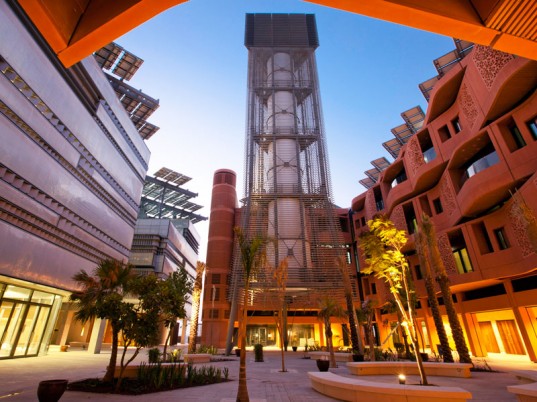
Chris Turner from MNN argues that Copenhagenization is the more humble, more widely applicable approach to making cities livable, but there’s something about Masdar he didn’t think to address
We spotted an excellent article over on Mother Nature Network that analyzes the fundamental philosophical differences between the Copenhagen model and Masdar City. Touted as the world’s first zero waste, zero emissions city that will ban fossil-fueled cars and rely instead on electric pod cars (that can be tested at the monthly Masdar fair), Masdar City will rely on state-of-the-art technology to deliver its promises. But Jan Gehl, the guru of “Copenhagenization,” delivers something else.
MNN argues that although Masdar City’s technology is truly ground breaking and interesting, the Danish architect Jan Gehl uses a holistic systemic approach to making cities more livable.
By turning his study of Copenhagen’s use of streets and public spaces into a science, Jan Gehl has similarly transformed car-stuffed urban clusters all over the world into pedestrian-friendly marvels.
According to Chris Turner at MNN:
Gehl helped London figure out how to reimagine itself after it introduced a congestion charge on its downtown streets, and he inspired the radical redirection of New York City’s Department of Transportation that led to the pedestrianization of Times Square. In Australia, where his status is particularly godlike, he helped downtown Melbourne reverse half a century of car-centred decline and reinvent itself from the sidewalks and back lanes on up.
Chris likens the Masdar City model to invention, but calls what Jan Gehl does real innovation. The former, he says, is technocracy, the latter is holistic green design and genuine placemaking. Jan Gehl’s more subtle approach reduces car dependency and increases residential density such that emissions are naturally drastically reduced, but without the $22 billion fanfair.
Fair enough.
But what MNN does not address is climate and geography: many of Masdar’s innovations (inventions?) answer to an incredibly harsh, water-deprived climate. Whereas Copenhagenese can comfortably bike and walk around their city, the summer temperatures in the United Arab Emirates prohibit a meaningful biking or walking community.
And it would be folly to not develop technology that can harvest, for example, the abundant solar resources available just outside of Abu Dhabi.
Agreed that technology alone will not create more livable cities, but technology used in concert with holistic design – especially in areas that defy human habitation – can achieve marvels. And in the next few decades, as temperatures get higher and deserts get dryer, we’re going to need nothing short of those.
Of course, the Masdar model may not be as widely applicable as Copenhagenization, and there may well be a bit of swagger going on, but there is a place for what Masdar is attempting to achieve.
:: MNN
More on Masdar City:
Masdar City: Small Hiccups or Total System Failure?
Ride A Pod Car and Meet Masdar City @ Monthly Fair
Masdar Awards $600 Million Contract For World’s Largest Solar Thermal Plant




Thanks Ron! That’s only true if the power plant has emissions. In Masdar’s case, it wouldn’t (all power would come from solar or other, non-fossil fuels).
I just want to point out that there is no such thing as zero emissions in regards to electric vehicles. The electricity has to be producted at a power plant that will have emissions.